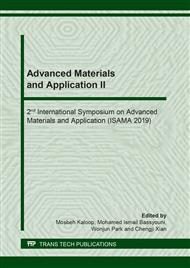[1]
S. Kumai, K. Suzuki, Y. Saito, T. Haga, A high speed twin roll caster for aluminum alloy thin strip, Trans. Mater. Res. Soc. Japan, 29 (2004) 1823-1828.
DOI: 10.2320/matertrans.45.403
Google Scholar
[2]
T. Haga, H. Watari, S. Kumai, High speed roll casting of aluminum alloy strip, J. Mater. Sci. Forum, 475 (2005) 343-348.
Google Scholar
[3]
T. Haga, H. Watari, S. Kuma, High speed roll casting of Mg alloy strip by a vertical type twin roll caster, J. Achiev. Mater. Manuf. Eng. 15 (2006) 186-192.
DOI: 10.4028/p-674o3a
Google Scholar
[4]
R. Cook, P.G. Groock, P.M. Thomas, D.V. Edmonds, J.D. Hunt, Development of the twin-roll casting process, J. Mater. Process. Technol., 55 (1995) 76-84.
DOI: 10.1016/0924-0136(95)01788-7
Google Scholar
[5]
M. Cortes, Pechiney-Junmbo 3CM, The new demands of thin strip casting, Light Met. (1995) 1161-1164.
Google Scholar
[6]
B. Taraglio, C. Romanowski, Thin-gage/high-speed roll casting technology for foil production, Light Met (1995) 1165-1182.
Google Scholar
[7]
A. I. Nussbaum, Three-state-of-the-art Thin –gage high-speed roll caster for aluminum alloy sheet products PartⅢ, Light Met Age, 55 (1997) 34-39.
Google Scholar
[8]
O. Daland, A. B. Espedal, M. L. Nedreberg, I. Alvestad, Thin gage twin-roll casting, process capabilities and product quality, Light Met. (1997) 745-752.
DOI: 10.1007/978-3-319-48228-6_125
Google Scholar
[9]
P. Y. Menet, R. Cayol, J. Moriceau, Pechiney Jumbo 3CM TM, start-up of the Neu-Brisach thin strip caster, Light Met. (1997)753-756. R.J. Ong, J.T. Dawley and P.G. Clem: submitted to Journal of Materials Research (2003).
Google Scholar
[10]
T. Haga, H. Watari, Casting of clad strip by a vertical type twin roll caster, Manuf. Sci. Tech. 3 (2015) 197-203.
DOI: 10.13189/mst.2015.030501
Google Scholar
[11]
T. Haga, Casting of Clad Strip by a Twin Roll Caster, Mater. Sci. Forum, 794-796 (2014) 772-777.
DOI: 10.4028/www.scientific.net/msf.794-796.772
Google Scholar
[12]
R. Nakamura, T. Haga, S. Kumai, H. Watari, A vertical type twin roll caster for an aluminum alloy clad strip, J. Achiev. Mater. Manuf. Eng. 62 (2013) 36-44.
DOI: 10.4028/www.scientific.net/amr.97-101.1053
Google Scholar
[13]
T. Haga, H. Tsuge, S. Kumai, H. Watari, A Roll Caster to Cast Clad Strip, Key Eng. Mater. 554-557 (2013) 1902-1909.
DOI: 10.4028/www.scientific.net/kem.554-557.1902
Google Scholar
[14]
T. Haga, R. Nakamura, S. Kumai, H. Watari, Roll casting of clad strip, Mater. Sci. Forum, 706-709 (2012) 1152-1157.
DOI: 10.4028/www.scientific.net/msf.706-709.1152
Google Scholar
[15]
R. Nakamura, T. Yamabayashi, T. Haga, H. Watari, S.Kumai, Casting of aluminum alloy clad strip using a roll caster, J. Solid Mech. Mater. Eng. 5 (2011) 1029-1041.
DOI: 10.1299/jmmp.5.1029
Google Scholar
[16]
T. Haga, R. Nakamura, S. Kumai, H. Watari, Clad strip casting by a roll caster, Appl. Mech. Mater. 52-54(2011) 775-778.
DOI: 10.4028/www.scientific.net/amm.52-54.755
Google Scholar
[17]
R. Nakamura, T. Haga, H. Tsuge, S. Kumai, H. Watari, Casting of clad strip by a roll caster, Mater. Sci. Forum, 675-677(2011) 807-810.
DOI: 10.4028/www.scientific.net/msf.675-677.807
Google Scholar
[18]
T. Haga, R. Nakamura, S. Kumai, H. Watari, Clad strip casting by a twin roll caster, Archiv. Mater. Sci. Eng. 37 (2009) 117-124.
DOI: 10.1007/978-1-84996-432-6_8
Google Scholar
[19]
T. Haga,K. Okamura, S. Nishida, H. Watari, K. Matsuzaki, Casting of an Mg Alloy Clad Strip Using a Twin Roll Caster Equipped with a Scraper, Mater. Sci. Forum, 879 (2017) 671-676.
DOI: 10.4028/www.scientific.net/msf.879.671
Google Scholar
[20]
T. Haga, R. Kozono, S. Nishida, H. Watari, Casting of aluminum alloy clad strip by an unequal diameter twin-roll caster equipped with a scraper, Adv. Mater. Proc. Tech. 3 (2017) 511-521.
DOI: 10.1080/2374068x.2017.1344057
Google Scholar
[21]
T. Haga, K. Ikeda, T. Nakano, Roll Casting of 400 mm Width Al-40%Sn-1%Cu Clad Strip, Mater. Sci. Forum, 904 (2017) 3-8.
DOI: 10.4028/www.scientific.net/msf.904.3
Google Scholar


